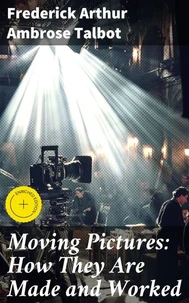Aeroplanes and Dirigibles of War. Unveiling the Aerial Arsenal: Innovations in War Technology during World War I
Par :Formats :
Disponible dans votre compte client Decitre ou Furet du Nord dès validation de votre commande. Le format ePub est :
- Compatible avec une lecture sur My Vivlio (smartphone, tablette, ordinateur)
- Compatible avec une lecture sur liseuses Vivlio
- Pour les liseuses autres que Vivlio, vous devez utiliser le logiciel Adobe Digital Edition. Non compatible avec la lecture sur les liseuses Kindle, Remarkable et Sony
 , qui est-ce ?
, qui est-ce ?Notre partenaire de plateforme de lecture numérique où vous retrouverez l'ensemble de vos ebooks gratuitement
Pour en savoir plus sur nos ebooks, consultez notre aide en ligne ici
- Nombre de pages220
- FormatePub
- ISBN4057664631688
- EAN4057664631688
- Date de parution22/11/2019
- Protection num.Digital Watermarking
- Taille541 Ko
- Infos supplémentairesepub
- ÉditeurGOOD PRESS
Résumé
In "Aeroplanes and Dirigibles of War, " Frederick Arthur Ambrose Talbot presents a meticulously detailed examination of aerial warfare's transformative role during the early 20th century. The book is rich in both visual and textual information, utilizing a blend of descriptive prose and technical illustrations to elucidate the evolving technologies in military aviation. Talbot contextualizes the strategic implications of aeroplanes and dirigibles, providing readers with a thorough understanding of their impact on warfare and international relations, particularly during World War I, a pivotal period for both aviation innovation and military strategy.
Frederick Arthur Ambrose Talbot was not only a prominent aviation writer but also a pioneering engineer and inventor. His deep-rooted fascination with aeronautics, combined with experiences during the Great War, fueled his desire to document the rapid advancements in aerial technology. Talbot's unique position'Äîstraddling the worlds of engineering and journalism'Äîafforded him the insight necessary to craft a compelling narrative that blends technical rigor with accessible storytelling, capturing the imagination of his contemporaries and descendants alike.
This book is a must-read for historians, aviation enthusiasts, and anyone interested in military technology. Talbot'Äôs authoritative insights reveal how the convergence of innovation and strategy shaped contemporary understandings of warfare. Readers will appreciate the intersection of history and technology, making it an invaluable resource for both academic study and personal interest.
Frederick Arthur Ambrose Talbot was not only a prominent aviation writer but also a pioneering engineer and inventor. His deep-rooted fascination with aeronautics, combined with experiences during the Great War, fueled his desire to document the rapid advancements in aerial technology. Talbot's unique position'Äîstraddling the worlds of engineering and journalism'Äîafforded him the insight necessary to craft a compelling narrative that blends technical rigor with accessible storytelling, capturing the imagination of his contemporaries and descendants alike.
This book is a must-read for historians, aviation enthusiasts, and anyone interested in military technology. Talbot'Äôs authoritative insights reveal how the convergence of innovation and strategy shaped contemporary understandings of warfare. Readers will appreciate the intersection of history and technology, making it an invaluable resource for both academic study and personal interest.
In "Aeroplanes and Dirigibles of War, " Frederick Arthur Ambrose Talbot presents a meticulously detailed examination of aerial warfare's transformative role during the early 20th century. The book is rich in both visual and textual information, utilizing a blend of descriptive prose and technical illustrations to elucidate the evolving technologies in military aviation. Talbot contextualizes the strategic implications of aeroplanes and dirigibles, providing readers with a thorough understanding of their impact on warfare and international relations, particularly during World War I, a pivotal period for both aviation innovation and military strategy.
Frederick Arthur Ambrose Talbot was not only a prominent aviation writer but also a pioneering engineer and inventor. His deep-rooted fascination with aeronautics, combined with experiences during the Great War, fueled his desire to document the rapid advancements in aerial technology. Talbot's unique position'Äîstraddling the worlds of engineering and journalism'Äîafforded him the insight necessary to craft a compelling narrative that blends technical rigor with accessible storytelling, capturing the imagination of his contemporaries and descendants alike.
This book is a must-read for historians, aviation enthusiasts, and anyone interested in military technology. Talbot'Äôs authoritative insights reveal how the convergence of innovation and strategy shaped contemporary understandings of warfare. Readers will appreciate the intersection of history and technology, making it an invaluable resource for both academic study and personal interest.
Frederick Arthur Ambrose Talbot was not only a prominent aviation writer but also a pioneering engineer and inventor. His deep-rooted fascination with aeronautics, combined with experiences during the Great War, fueled his desire to document the rapid advancements in aerial technology. Talbot's unique position'Äîstraddling the worlds of engineering and journalism'Äîafforded him the insight necessary to craft a compelling narrative that blends technical rigor with accessible storytelling, capturing the imagination of his contemporaries and descendants alike.
This book is a must-read for historians, aviation enthusiasts, and anyone interested in military technology. Talbot'Äôs authoritative insights reveal how the convergence of innovation and strategy shaped contemporary understandings of warfare. Readers will appreciate the intersection of history and technology, making it an invaluable resource for both academic study and personal interest.



